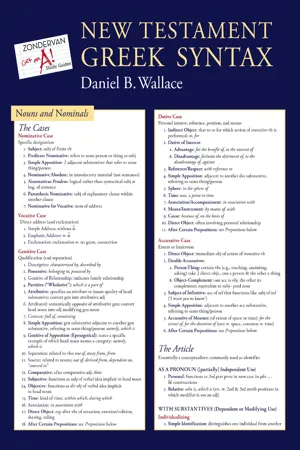
- 6 pages
- English
- ePUB (mobile friendly)
- Available on iOS & Android
eBook - ePub
New Testament Greek Syntax Laminated Sheet
About this book
This summary laminated sheet of Greek Grammar beyond the Basics and Basics of New Testament Syntax is perfect for students to review categories of uses and look over possibilities when doing exegesis of the New Testament.
Frequently asked questions
Yes, you can cancel anytime from the Subscription tab in your account settings on the Perlego website. Your subscription will stay active until the end of your current billing period. Learn how to cancel your subscription.
No, books cannot be downloaded as external files, such as PDFs, for use outside of Perlego. However, you can download books within the Perlego app for offline reading on mobile or tablet. Learn more here.
Perlego offers two plans: Essential and Complete
- Essential is ideal for learners and professionals who enjoy exploring a wide range of subjects. Access the Essential Library with 800,000+ trusted titles and best-sellers across business, personal growth, and the humanities. Includes unlimited reading time and Standard Read Aloud voice.
- Complete: Perfect for advanced learners and researchers needing full, unrestricted access. Unlock 1.4M+ books across hundreds of subjects, including academic and specialized titles. The Complete Plan also includes advanced features like Premium Read Aloud and Research Assistant.
We are an online textbook subscription service, where you can get access to an entire online library for less than the price of a single book per month. With over 1 million books across 1000+ topics, we’ve got you covered! Learn more here.
Look out for the read-aloud symbol on your next book to see if you can listen to it. The read-aloud tool reads text aloud for you, highlighting the text as it is being read. You can pause it, speed it up and slow it down. Learn more here.
Yes! You can use the Perlego app on both iOS or Android devices to read anytime, anywhere — even offline. Perfect for commutes or when you’re on the go.
Please note we cannot support devices running on iOS 13 and Android 7 or earlier. Learn more about using the app.
Please note we cannot support devices running on iOS 13 and Android 7 or earlier. Learn more about using the app.
Yes, you can access New Testament Greek Syntax Laminated Sheet by Daniel B. Wallace in PDF and/or ePUB format, as well as other popular books in Teología y religión & Lenguas antiguas. We have over one million books available in our catalogue for you to explore.
Information
Topic
Teología y religiónSubtopic
Lenguas antiguasVerbs and Verbals
VOICE
Indicates how subject is related to the action or state expressed by the verb
Active
Subject performs or experiences the action or exists in the state expressed by the vb
1. Simple: subj performs or experiences vb’s action
2. Causative (Ergative): subj is ultimate source or cause of vb’s action: cause to + vb
3. Stative: subj exists in state indicated by vb
4. Reflexive: subj acts upon himself/herself (reflexive pron is the dir obj)
Middle
Subject performs or experiences action expressed by the vb so as to emphasize the subj’s participation
1. Direct: subj acts on himself/herself: vb + self (as dir obj)
2. Indirect (Benefactive, Intensive, Dynamic): subj acts for himself/herself, or in his/her own interest
3. Permissive: subj allows something to be done for or to himself/ herself
4. Deponent: middle in form but active in meaning
Passive
Subject is acted upon or receives the action expressed by the vb
1. Simple: subj receives the action of the vb
2. Deponent: passive in form but active in meaning
MOOD
The feature of the verb that presents verbal action or state with reference to its actuality or potentiality
Indicative
The mood of assertion, or presentation of certainty
1. Declarative: presents assertion as non-contingent (or unqualified) statement
2. Interrogative: asks question that expects assertion
3. Conditional: See Conditional Sentences below
4. Potential: assertion of obligation, wish, or desire (ὀφείλω; δεῖ; βούλομαι; θέλω) + inf
5. Indicative with Ὅτι:
A. Substantival Ὅτι Clauses (that): Subj, Dir Obj, Direct Discourse, Indirect Discourse, Apposition (namely, that)
B. Epexegetical: explains or clarifies or completes previous word or phrase
C. Causal (Adverbial): because
Subjunctive
Represents verbal action (or state) as uncertain but probable; grammaticalizes potentiality (may be cognitive probability or volitional intentionality)
IN INDEPENDENT CLAUSES
1. Hortatory (Volitive): exhort oneself & one’s associates: let us (1st pers pl)
2. Deliberative (Dubitative): asks real (cognitive: How can we . . . ?) or rhetorical question (volitional: Should we . . . ?)
3. Emphatic Negation: οὐ μή plus the aorist subjunctive (strong negation)
4. Prohibitive: like prohibitive imper (usu. μή + aorist subj)
IN DEPENDENT CLAUSES
1. Subjunctive in Conditional Sentences: See Conditional Sentences below
2. Ἵνα + Subjunctive
A. Purpose Ἵνα Clause (in order that)
B. Result Ἵνα Clause (so that, with the result that)
C. Purpose-Result Ἵνα Clause: indicates both intention & accomplishment (in order that)
D. Substantival Ἵνα Clause (Subfinal): subj, pred nom, dir obj, apposition
3. Subjunctive with Verbs of Fearing: μή + subj after vbs of fearing, warning, watching out for
4. Subjunctive in Indirect Questions: indirect deliberative question
5. Subjunctive in Indefinite Relative Clause: subj used after ὅστις (ἄν/ἐάν) or ὅς (δ’) ἄν
6. Subjunctive in Indefinite Temporal Clause: subj after tempor...
Table of contents
- Cover Page
- Title Page
- Copyright Page
- Contents
- Nouns and Nominals
- Preposition
- Verbs and Verbals
- Syntax of the Clause